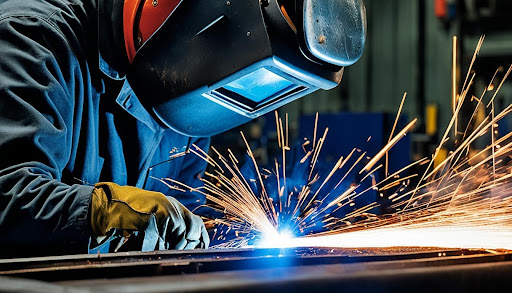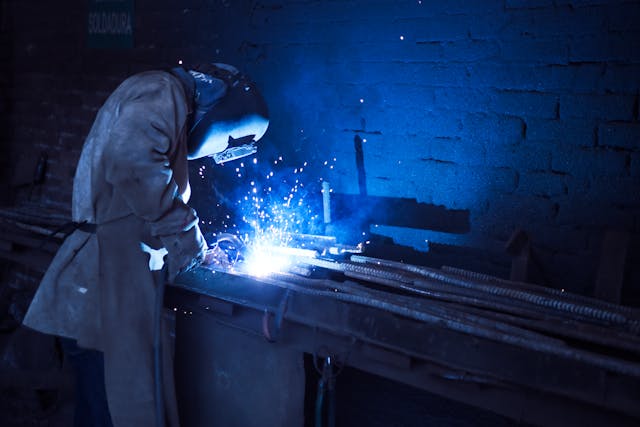Mechanical welding is a key technique in metalworking. It’s used in fields like aeronautics, automotive, and construction. It helps make complex structures such as metal frames and robotic cells.
Welded assemblies use different metals like sections and sheets. They also use materials like aluminum and steel. This process is vital for making these metal parts strong and reliable.

Welding heats materials to melt them together. It uses arcs, lasers, and flames for this. Sometimes, extra material is added to make the joints stronger.
Designing joints right is key for a strong weld. Factors like the shape of the groove matter a lot. There are many welding methods, like shielded metal arc welding and TIG welding.
Welding is used in many areas, from cars to buildings. New trends like laser welding and additive manufacturing are making welding even more versatile.
Understanding Mechanical Welding Processes
Gas Metal Arc Welding (GMAW/MIG)
Gas Metal Arc Welding (GMAW), also known as Metal Inert Gas (MIG) welding, is a top choice for many. It uses a wire electrode and shielding gas to protect the weld area. This method works well with metals like stainless steel, copper, and aluminum.
It’s easy to learn and use, making it great for both small and large projects. Automation with robots makes it even better, boosting speed and quality. GMAW is the top welding method for many tasks, especially in heavy-duty welding.
Welding Process | Key Applications |
| Gas Metal Arc Welding (GMAW/MIG) | Plate and large bore pipe welding |
| Gas Tungsten Arc Welding (GTAW/TIG) | Welding thick sections of stainless steel and non-ferrous metals |
| Shielded Metal Arc Welding (SMAW) | Joining carbon steel, alloyed steels, stainless steel, cast iron, and ductile iron |
| Flux Cored Arc Welding (FCAW) | High welding speed and portability, suitable for construction projects |
| Electroslag Welding (ESW) | Joining thin metal plates together edge-to-edge vertically, mostly for low carbon steel plates |
| Plasma Arc Welding (PAW) | Assembling delicate and heat-sensitive devices like microchips and medical devices |
| Laser Beam Welding (LBW) | Utilized on metals or thermoplastics, mostly in automotive manufacturing |
As technology advances, mechanized welding like GMAW will become more common by 2026. This is due to a lack of skilled welders. Mechanized welding brings precision, consistency, and boosts productivity. It also makes welding safer by reducing dangerous manual tasks.
Mastering the Art of Mechanical Welding
To become a skilled welder, you need to learn different welding techniques and know when to use them. It’s important to have a steady hand, a sharp eye, and an artistic touch. The type of metal, its thickness, and the welding environment also affect the best mechanical welding process to use.
To improve their skills, welders must keep practicing and learn about new welding technology. This commitment to welding best practices helps them succeed in industries that need strong and precise welding.
Welding is more than just a job; it’s an art that requires precision, patience, and knowledge of materials. By getting good at TIG welding, MIG welding, and arc welding, welders can make high-quality welds. This meets the high standards of the industrial welding world.
Welding Technique | Recommended Applications |
| TIG Welding | Precision welding with high-quality work |
| Stick/Flux-Cored Welding | Powerful welds between rusty or dirty metals |
| MIG Welding | Ideal for steel and stainless steel |
By practicing and trying new welding techniques, welders can get better at their job. Whether they’re working on car parts or big industrial projects, being good at mechanical welding shows their hard work and creativity.
“Welding is not just a job, it’s a craft. To be a master welder, you must have a passion for the art and a relentless pursuit of perfection.”
Advanced Mechanical Welding Techniques
Plasma Arc Welding (PAW)
The world of welding has seen new techniques emerge, like Plasma Arc Welding (PAW). This method uses a high-temperature, high-velocity plasma arc to melt and join metals. It’s great for welding materials that are easily damaged by heat, like microchips and medical devices.
PAW is not just for delicate items. It’s also used in making steel tubing, electronic parts, and other items needing high accuracy. This technique lets welders control the heat and arc well. This results in strong welds with little distortion.
PAW is perfect for detailed work or big projects. It combines precision, efficiency, and versatility. This makes it a key welding technique for many tasks.
Conclusion
Mechanical welding is key to making complex metal structures and products. It’s used in many industries, from electronics to large frameworks. Welders use techniques like Gas Metal Arc Welding (GMAW) and Flux Cored Arc Welding (FCAW) to make sure their work is strong and precise.
By 2026, mechanical welding will make up 20% of all welds, thanks to a shortage of skilled workers. Keeping up with new welding techniques is vital for welders. Automated welding systems bring more precision, speed, and safety to industries like oil and gas, construction, and manufacturing.
Automated welding may cost more at first, but it saves money on labor and reduces waste over time. It also uses less energy. As welding tech gets better, with robots and AI making systems smarter, mechanical welding will become even more important in making things.
FAQ
What is mechanical welding?
Mechanical welding is a way to make complex structures. It’s used in fields like aeronautics, automotive, and construction. It helps create metal frames, handling systems, and robotic cells.
What materials are used in mechanical welded assemblies?
These assemblies use metals like sections, tubes, and sheets. They also use materials like aluminum, stainless steel, titanium, steel, and copper alloys.
What is Gas Metal Arc Welding (GMAW/MIG)?
GMAW, or Metal Inert Gas (MIG) welding, is a common welding method. It uses a wire electrode and shielding gas to protect the weld. This process works well with metals like stainless steel, copper, nickel, carbon steel, and aluminum.
What are the benefits of becoming a skilled welder?
Being a skilled welder means knowing how to use different welding techniques. It also means having a steady hand and an eye for detail. By improving their skills and learning new welding tech, welders can make a big impact in industries that need strong and precise welds.
What is Plasma Arc Welding (PAW)?
PAW is a precise welding method that uses a high-temperature plasma arc. It’s great for welding small and delicate materials like microchips and medical devices. It also works well for making steel tubing and electronic components that need high accuracy.







